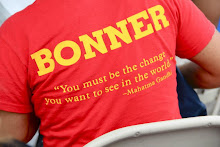First and Foremost, I wanted to take this opportunity to give my sincere thanks and a token of my appreciation to Pat Donuhue, Giametta Giancarlo, Rich Wilson, and especially the one and only Sejour Stephens for helping make this amazing trip possible. The trip not only helped me get to know better my fellow Bonner classmates but it also enriched me with knowledge regarding one of our country’s past times and gave me a different perspective in viewing the Civil War. Despite being such a short trip, I still gained a lot of insight about Richmond and it’s historic slave story.
Before traveling to Richmond, I imagined that the whole purpose of this trip was only to observe and recollect information we already knew; however, I took with me more than just information. What I took away from this trip was a new comprehensive outlook on slavery and how it affected Richmond’s history. I began to notice this when we first went to the Historic Slave Trail Tour. Our tour guide, the humorous and quirky Ralph, helped us see how slaves came to Richmond and how they were sold and used for a growing business. We were given the chance to be put in the same situation the slaves were when they first arrived to the Americas. Ralph had all of us traverse across a part of the slave trail by being constrained to one another simply by holding hands or grabbing on to each other’s shoulders. This helped me see how difficult it was just trying to move as a slave. It was difficult to keep up when we were held together and I can only imagine how much more difficult it would have been if we were actually cuffed and shackled in chains with little clothing.
Slaves who decided to rebel were later punished and imprisoned in a place called Lumpkin’s Jail. The jail, which sat upon a half acre of land known as "Devil's Half Acre," was the largest slave trade site outside of New Orleans before it was liberated during the Civil War in the 1800's. Robert Lumpkin was the owner of Lumpkin's Jail, a two-story brick house with barbed windows, and where hundreds of thousands of slaves were housed as they brought into the country and sold to slave owners. Like I said before, it was also a prison where rebellious slaves were whipped and held in a heated room filled with excrement and filth. Slaves were also slapped with wooden boards with holes inside in order to create large blisters. Unexpectedly, Lumpkin eventually fell in love with one of his slaves, Mary, whom he freed and married and left the property to when he died. Ironically enough, she later leased it to a man who began teaching freed blacks and that school grew into what became Virginia Union University today. The tour ended with Ralph telling us that races have tried to hide the past; however, the past will continue to exist until people understand the gruesome history that they have left behind.
The next day, we all had the opportunity to see the beautiful campus that the University of Richmond had to offer. Its 350 acres of colorful trees, open lawns, red brick collegiate gothic style buildings, rolling hills, and Westhampton Lake definitely make it one of the most beautiful campuses I have ever seen. There, we also got the chance to meet with other Bonner scholars. It was interesting to see how many things we all had in common. Nonetheless, I believe that the thing that really brought us together was our belief in community service. It was our enthusiasm for volunteering that really helped us appreciate the different sites they helped volunteer at. What intrigued me was that the sites they showed us that they had a good background in medicine. We visited and EMT squad/cadet program and a hospital where two of the sites have been at. It was interesting to see that people in their Bonner program learned a lot about complex material such as science. For example, one of the Bonners was a business major and he still knew how to operate under an EMT program, something drastically different than his area of concentration.
Later that day, we were also given the chance to have a tour of the American Civil War Center. The exhibit presents the story of the Civil War, its causes, course, and its legacies from the viewpoints of Unionists, Confederates, and African Americans -- the war's three main participant groups. It was interesting to see the different perspectives of the three groups because they were fighting for something they passionately believed in. I observed that the central tragedy, the great irony of the war, is that all three groups were fighting for the legacy of the American Revolution, but they profoundly disagreed about what that legacy was. This was made known to me when I saw how hard each of the three groups tried to uphold the foundation of their beliefs. The history behind each story was just enormous and I was definitely impressed by the amount of depth we all carry within our races.
Overall the trip was an amazing experience that gave me a more comprehensive perspective of the Civil War. Not only did I learn but I also shared this experience with a great group of people. I hope there are more journeys like this to come because this trip was definitely one to remember. I will always cherish the bond with the new friends I made. Again, I thank those people who made all this possible. Thank you Bonner.
-Randolph Portugal
Thursday, March 25, 2010
Subscribe to:
Post Comments (Atom)

This comment has been removed by the author.
ReplyDelete